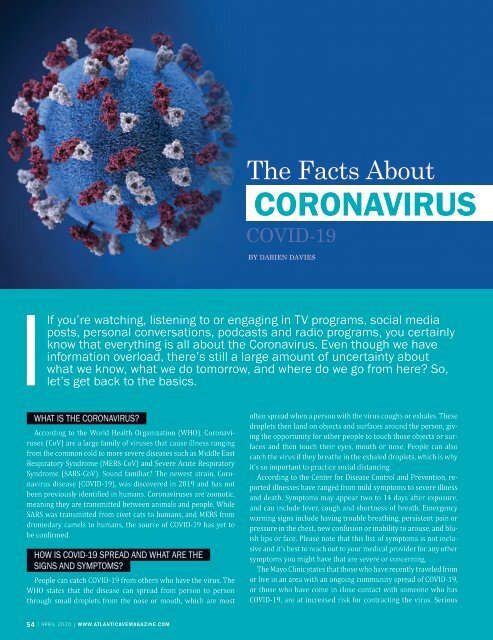Atlantic Ave Magazine - April 2020 Issue
- No tags were found...
Create successful ePaper yourself
Turn your PDF publications into a flip-book with our unique Google optimized e-Paper software.
The Facts About<br />
Coronavirus<br />
COVID-19<br />
By Darien Davies<br />
If you’re watching, listening to or engaging in TV programs, social media<br />
posts, personal conversations, podcasts and radio programs, you certainly<br />
know that everything is all about the Coronavirus. Even though we have<br />
information overload, there’s still a large amount of uncertainty about<br />
what we know, what we do tomorrow, and where do we go from here? So,<br />
let’s get back to the basics.<br />
What is the Coronavirus?<br />
According to the World Health Organization (WHO), Coronaviruses<br />
(CoV) are a large family of viruses that cause illness ranging<br />
from the common cold to more severe diseases such as Middle East<br />
Respiratory Syndrome (MERS-CoV) and Severe Acute Respiratory<br />
Syndrome (SARS-CoV). Sound familiar? The newest strain, Coronavirus<br />
disease (COVID-19), was discovered in 2019 and has not<br />
been previously identified in humans. Coronaviruses are zoonotic,<br />
meaning they are transmitted between animals and people. While<br />
SARS was transmitted from civet cats to humans, and MERS from<br />
dromedary camels to humans, the source of COVID-19 has yet to<br />
be confirmed.<br />
How is COVID-19 Spread and What are the<br />
Signs and Symptoms?<br />
People can catch COVID-19 from others who have the virus. The<br />
WHO states that the disease can spread from person to person<br />
through small droplets from the nose or mouth, which are most<br />
often spread when a person with the virus coughs or exhales. These<br />
droplets then land on objects and surfaces around the person, giving<br />
the opportunity for other people to touch those objects or surfaces<br />
and then touch their eyes, mouth or nose. People can also<br />
catch the virus if they breathe in the exhaled droplets, which is why<br />
it’s so important to practice social distancing.<br />
According to the Center for Disease Control and Prevention, reported<br />
illnesses have ranged from mild symptoms to severe illness<br />
and death. Symptoms may appear two to 14 days after exposure,<br />
and can include fever, cough and shortness of breath. Emergency<br />
warning signs include having trouble breathing, persistent pain or<br />
pressure in the chest, new confusion or inability to arouse, and bluish<br />
lips or face. Please note that this list of symptoms is not inclusive<br />
and it’s best to reach out to your medical provider for any other<br />
symptoms you might have that are severe or concerning.<br />
The Mayo Clinic states that those who have recently traveled from<br />
or live in an area with an ongoing community spread of COVID-19,<br />
or those who have come in close contact with someone who has<br />
COVID-19, are at increased risk for contracting the virus. Serious<br />
54 | april <strong>2020</strong> | www.<strong>Atlantic</strong><strong>Ave</strong><strong>Magazine</strong>.com

















